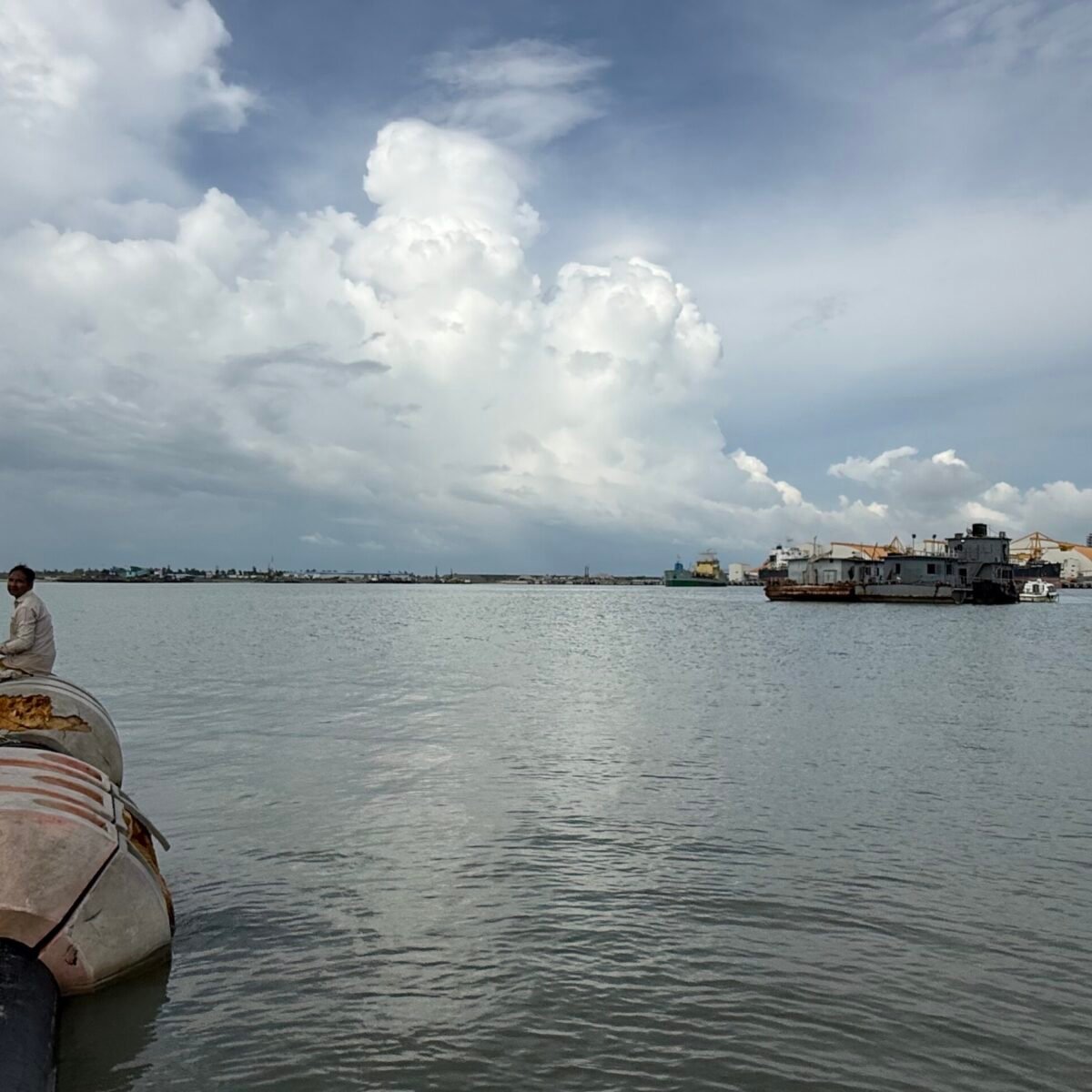For years, fisherman Sami Uddin lived and worked on a small patch of coastal land in southeastern Bangladesh – until the site was earmarked for development including a new cyclone-resistant deep-sea port, funded by Japan in the name of climate change adaptation.
“The development is [meant to help us] all, but the reality is that it takes our homes, professions, and they are forcing us to be evicted from our village,” Uddin, 51, said close to the port site in Matarbari, adding that new fishing restrictions nearby have fuelled local people’s anger.
The deep-sea port – being built next door to a new coal-fired power plant, also financed by Japan – is a centrepiece of Bangladesh’s ambitions to develop a “Singapore-style” economic hub on its climate-vulnerable Bay of Bengal coastline, a low-lying belt of densely populated land, prone to deadly tropical cyclones and flooding.
Funded with a $726-million concessional loan, half of which was counted by Japan as climate adaptation finance, the port marks the biggest single climate adaptation project being funded by a wealthy country in 2023, according to an analysis by Climate Home News of the latest data compiled by the Organisation for Economic Co-operation and Development (OECD).
But like other foreign-funded projects classed as “climate adaptation”, Climate Home’s reporting raises questions about whether the port investment will help climate-vulnerable local communities cope with the effects of more extreme weather and rising seas.
Japan’s development agency said the resilience measures to protect the port are crucial to preventing economic shocks and the disruption of essential services in case of disasters, while some interventions could also keep local people safer when storms hit.
COP30 president warns of ‘dystopian scenario’
Climate adaptation is set to be a key theme at next month’s COP30 UN climate summit in Brazil, and calls are growing for rich nations to increase their support for projects to help developing countries that are bearing the brunt of worsening climate impacts.
COP30 president André Aranha Corrêa do Lago said last week that the UN talks should take concrete steps to help vulnerable people adapt to a warming world and avoid a “dystopian scenario” in which only the rich can afford to protect themselves from climate threats.
But with just a fraction of needs for adaptation funding currently being met, according to the latest UN estimates, climate campaigners told Climate Home News that mega-projects like Matarbari are not the best way to protect the world’s poorest people from climate change.
They are also sounding the alarm about how a lack of uniform reporting rules and poor transparency in the data give countries free rein over what they label as adaptation finance.
Some donors “cheat” by focusing more on inflating numbers than on delivering real impact, said John Nordbo, senior climate advisor at NGO CARE Denmark and co-author of the annual “Climate Finance Shadow Report”.
“They label large projects with little or no adaptation component as ‘climate finance’,” he told Climate Home News. “It’s misleading – and when exposed, it undermines trust in the entire global climate regime.”
The $363 million provided by Japan for the Matarbari port was counted as adaptation finance under official data used to measure whether donors are meeting their promises on climate finance made at UN talks. It accounted for an estimated 15% of Japan’s total contributions to climate adaptation in 2023 – the latest year for which data is available.


“No one must be left behind”
When, at COP26, Japan committed to doubling its assistance for adaptation to $14.8 billion in public and private finance by 2025, its then Prime Minister Fumio Kishida told fellow world leaders “no one must be left behind as we confront the issue of climate change”. He added that investments would focus on disaster risk reduction.
Japan said the delivery of that pledge was “on track” in its latest assessment report for the UN earlier this year.
But Climate Home’s analysis of the data from the OECD – the main body tracking global climate finance flows from industrialised nations – found that in 2023 Tokyo channelled at least a third of its bilateral adaptation finance into large-scale infrastructure projects and broad health programmes that lacked clear climate adaptation objectives.
It counted loans worth hundreds of millions of dollars for the construction of mass rapid transit in Jakarta and the rollout of universal health coverage in Egypt as adaptation finance, for example. It offered no explanation in project documents of how either initiative would strengthen resilience to climate impacts.
It also reported a $200-million grant to the global vaccine alliance, Gavi, to support its COVID-19 response as having “significant” relevance for climate adaptation. In an assessment of Gavi in 2024, the Multilateral Performance Network described as a “serious challenge” the fact that addressing climate change was not yet a core objective within the alliance’s strategy.
Md Shamsuddoha, a former climate negotiator for Bangladesh who now leads the Center for Participatory Research and Development, said Japan repackages “pure investment projects” for infrastructure development as climate finance to show it is meeting its commitments made under the UN climate regime.
“Japan should not do this, because that is no climate finance at all,” Shamsuddoha added.
Japan’s Ministry of Foreign Affairs and its overseas aid arm, the Japan International Cooperation Agency (JICA), were approached for comment on the adaptation relevance of these projects, but had not responded by the time of publication.
Roadbuilding and energy projects
Climate Home’s analysis found Japan was not alone among major donors in labelling funds for large transport and energy infrastructure projects, or broad health programmes, as bilateral climate adaptation finance, which tends to be provided in grant form or as highly concessional lending to the poorest nations.
France and South Korea have used a similar approach, according to our analysis of the data from the OECD.
The three countries’ bilateral funding for those projects totalled at least $4 billion in 2023, but South Korea and France do not disclose the exact portion they have counted as climate adaptation finance.
According to the OECD data, France described loans provided for energy projects in developing countries as having a primary objective of adaptation, without giving a clear explanation of how they would boost climate resilience. They include strengthening electricity grids in Pakistan and Argentina, a hydropower plant in Tanzania and work to develop decarbonisation plans in Uzbekistan.
South Korea is not part of the group of developed countries under the UN climate regime and is therefore not obliged to provide climate finance to poor nations. But, in recent years, the country – one of the world’s largest economies – has hailed its “significant” support to the Global South for climate adaptation interventions.
Transport projects made up a significant portion of South Korea’s adaptation spending in developing countries in 2023. It counted the construction of a railway bridge in Bangladesh, a major highway in Vietnam and road networks in Cambodia and the Philippines among its top adaptation projects.
Hanna Hakko, a senior policy advisor at think-tank E3G, said developing countries have a critical need to build new resilient infrastructure and climate-proof what they already have.
“However, there is a need for clarity and guardrails around what counts as resilient infrastructure and to ensure impacted communities benefit from these projects and environmental impacts are minimised,” she added.
The climate ministries of South Korea and France had not responded to Climate Home’s request for clarifications on their adaptation finance at the time of publication.
Limited transparency in reporting system
Other donor governments such as Denmark, Switzerland and Finland take a more conservative approach, only counting pure climate adaptation activities or funding donated as grants in their spending.
But limited transparency in the reporting system makes it difficult to tell how much money overall is directed at efforts that truly help the most vulnerable communities to better cope with the escalating impacts of climate change.
Countries disclose brief and vague descriptions of the projects, often failing to offer details on their relevance for climate adaptation, Climate Home found.
Foreign aid cuts put adaptation finance pledge at risk, NGOs warn
Some European countries, including Germany, France and Italy, did not even identify a specific project or recipient nation for non-concessional funding worth hundreds of millions of dollars that was tagged as adaptation finance.
Ian Mitchell, a senior policy fellow at the Center for Global Development, said the problem lies with setting international goals to provide a certain amount of finance without a broadly agreed definition of what that finance can consist of.
“It is a pretty damaging state of affairs because these agreements are reached to motivate other countries to undertake climate action,” he added.
Focus on plugging adaptation gap
At the COP26 climate summit in Glasgow four years ago, developed countries committed to doubling adaptation funding for developing nations from 2019 levels to reach at least $40 billion by 2025.
That promise now looks set to be broken. According to the latest UN Environment Programme Adaptation Gap Report, international public adaptation funding from wealthy governments stood at only $26 billion in 2023 – falling slightly from the previous year.
UNEP’s report, released on Wednesday, warns that this year’s target “will be missed if current trends continue”.
Since 2023, widespread cuts to aid budgets amid geopolitical tensions and fiscal pressures have likely put the Glasgow goal further out of reach. Least-developed countries (LDCs), meanwhile, are pushing for a new goal to be set at COP30 to boost adaptation finance to about $100 billion a year by 2030.
Brazil’s COP presidency also wants to elevate climate adaptation, which has long missed out on political attention and funding directed instead to efforts to cut greenhouse gas emissions.
The renewed focus on adaptation in Belém could also increase scrutiny of how donor countries are allocating climate finance in countries like Bangladesh, and whose interests they are serving.
Climate-friendly coal plant?
Japan’s investments in Matarbari, for example, come as the country seeks to develop its economic ties with Bangladesh and counter China’s growing influence in the region.
Even the 1,200-megawatt coal-fired power plant, which JICA has financed with loans worth more than $2 billion, was counted by Japan as climate finance. It said the technology installed by Japanese firms made the plant more efficient, leading to a reduction in emissions compared to a conventional station.
The plant is expected to spew into the atmosphere nearly 7 million tonnes of carbon dioxide a year – equivalent to the total annual emissions generated by a small country like Mauritius.
As ships needed to deliver coal to fuel the plant, the developers built a port and a navigation channel connecting it to the ocean. Those facilities are now being expanded with the construction of the neighbouring deep-sea commercial port, which Japan agreed to fund in 2023 with a $726-million concessional loan.
Expected to be completed in 2029 by Japanese companies, the project aims to increase Bangladesh’s ability to handle cargo and spur economic activity in the area.
Takahiro Okamoto, who oversees the project at JICA’s Bangladesh office, said the inclusion of protections, like breakwaters, retaining walls and raised embankments, will shield the port and its access road from the impact of storm surges and cyclones.
“By allowing larger, more efficient ships to dock directly, the project reduces the country’s reliance on smaller, vulnerable ports and trans-shipment hubs in other countries, which might be more susceptible to disruptions from climate change and other factors,” Okamoto added.
Loss of salt and shrimp farms
Amid the bustle of construction activity, local residents in the area were sceptical about whether the development will make them better prepared for tidal surges or more frequent and severe storms.
Even if it does, they said the cost to their communities has been too high.
Over a third of the salt and shrimp farms in the area would be lost as a result of the construction, an impact assessment carried out by JICA found, adding that the mega-project would affect an area inhabited by almost 800,000 people.


Habibur Rahman, an unemployed 24-year-old man, said the development was not offering stable job opportunities for locals, while the coal power plant was causing growing pollution and damaging fishing activities.
“The [port] authority did not take a single project to develop our lives,” Rahman said.
Chittagong Port Authority and the Shipping Ministry did not reply to requests for comment.
JICA’s Okamoto said contractors are encouraged to employ local residents “as much as possible”, while 500 people have so far been trained under a programme that supports alternative income-generating activities.
He added that embankments built along the access road to the port to protect it would also serve as evacuation routes in disasters and that further protective measures may be considered as part of a separate plan being worked on by the Bangladesh government.
In the meantime, rising sea levels and stronger tidal flooding continue to chip away at the coast and swallow homes in the area, local media have reported.
“In no way [is] this an adaptation or resilience project,” Shamsuddoha said of the Matarbari development, saying it did not represent “resilient livelihoods” that would support coastal communities.
While developed countries pour their money into headline climate investment projects, the human dimension of adaptation is “completely missing”, he added.





